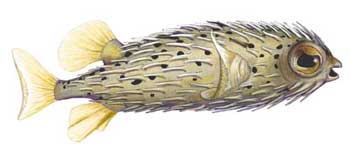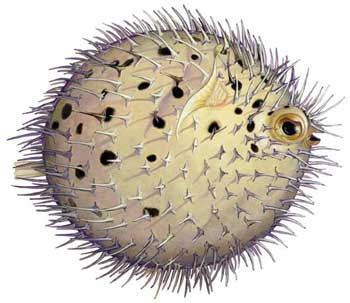Pufferfishes are the second most poisonous vertebrate in the world. They are made up of two families of closely related fishes, namely the smooth or sharpnose pufferfish (tetraodontidae) and spiny pufferfish (diodontidae). Though its skin and certain internal organs are highly toxic to humans, it is still a delicacy to some, with proper caution exercised in preparation of course.
Pufferfish Inflation as a Defense Mechanism
Natural defense mechanism is the key to the survival of the pufferfish. These mechanisms compensate for the locomotion and slow movement of the fish (Zimmer, 1997). Pufferfishes have a unique and distinct ability to inflate their body upon threatened, by swallowing water (if captured by predator) or air (if captured by avian or human) to fill their expandable stomachs, causing their body shape to become spherical. The ribs of the fish are short, and the collagen fiber organisation in it is modified, allowing its elastic stomach to stretch and expand (Wainwright and Turingan, 1997). Consequently, the swelling of the stomach can increase its body volume by up to three times!
Upon facing a large size fish now, many predators go into a pause and even retreat, giving the pufferfish the opportunity to make its getaway. Many predators are also unable to prey on the pufferfish as it becomes too large to swallow, and usually give up as seen in the video above. The fish can then easily return to its original size after the threat is no longer present, by expelling the water in its stomach.
In addition to its natural defense mechanism, pufferfishes also have chemical defenses in the form of toxins. Puffers produce a potent toxin to deter potential predators. This neurotoxin, called tetrodotoxin, is found in its internal organs such as its ovaries, livers, intestines, skin, muscle tissues and blood. Consuming a pufferfish might thus be a lethal and unpleasant thing for the predator. Thus, the natural defense mechanism not only protects the pufferfish, but can also protect the predator, as not preying on the former might be a blessing in disguise for the predator after all.
References:
“Puffer Fish,” by National Geographic. National Geographic YouTube Channel, 10 February 2009. URL: http://www.youtube.com/watch?v=OkXhC7yzISI&feature=PlayList&p=461B6262E80EED00&playnext_from=PL&playnext=1&index=1 (accessed on 6 April 2010)
“Pufferfish Inflation,” by Adam Summers. American Museum of Natural History, October 2001. URL: http://biomechanics.bio.uci.edu/_html/nh_biomech/pufferfish/puffer.htm (accessed on 6 April 2010)
“Marine Life Profile: Pufferfishes,” by Education Department, Waikiki Aquarium. University of Hawai’i-Manoa, September 2009. URL: http://www.waquarium.org/_library/images/education/marinelifeprofiles/pufferfishes0909.pdf (accessed on 6 April 2010)
“Observations of the Inflation Behavior of the Spiny Pufferfish,” by Keith Cavalieri, Tropical Biology. Providence College, Spring 2000. URL: http://people.hofstra.edu/jason_d_williams/HUML/Handbooks/30-Journal%20of%20Prov%20Coll.pdf (accessed on 6 April 2010)
Brainerd, Elizabeth L. 1994. Pufferfish Inflation: Functional Morphology of Postcranial Structures in Diodon holocanthus (tetraodontiformes). Journal of Morphology, 220: 243-261
Wainwright, Peter C. and Turingan, Ralph G. 1997. Evolution of Pufferfish Inflation Behavior. Evolution 51: 506-518
Zimmer, Carl. 1997. How the pufferfish got its puff. Discover 18(9): 30-31



